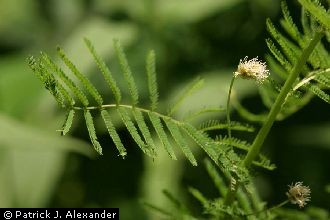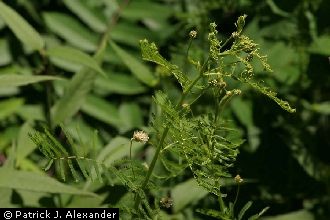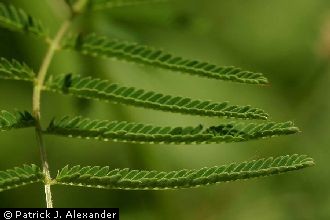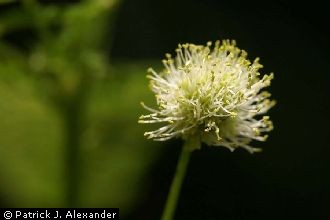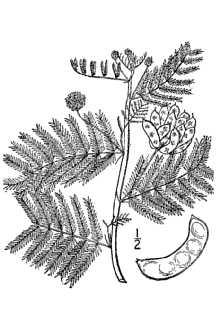Mimosa illinoensis Michx.
Scientific Name: Mimosa illinoensis Michx.
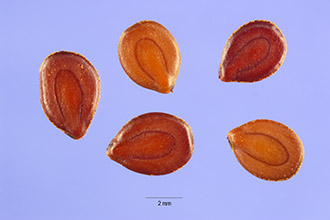
| General Information | |
|---|---|
| Usda Symbol | MIIL |
| Group | Dicot |
| Life Cycle | Perennial |
| Growth Habits | Forb/herbSubshrub, |
| Native Locations | MIIL |
Plant Guide
Status
Please consult the PLANTS Web site and your State Department of Natural Resources for this plant’s current status (e.g. threatened or endangered species, state noxious status, and wetland indicator values).
Description
General: The Legume family (Fabaceae). Illinois bundleflower is a warm season, self-pollinating, herbaceous, perennial, leguminous forb. Multiple stems grow from a woody caudex which is attached to the perennial root system of this legume species. Stems are glabrous, angled, longitudinally grooved and erect. The plant stands .6 to 1.3 meters in height. Its bipinnately compound leaves are alternately attached to the stem. Leaves are sensitive to external stimuli such as sunlight or touch which causes infolding of the leaflets. Flowers are white and five parted with 5 sepals, petals and stamens. The peduncles or stalks supporting the inflorescences are located in the leaf axil. The white globose heads produce clustered flat scythe-shaped pods which are slightly spirally twisted. Two to several seeds are contained within the dry dehiscent pods. The dark brown pods are broadly oblong and flat being 3 to 4 times longer than wide. Seeds are brown and 3 to 5 mm long, nearly as wide and mature in August. Kulakow (1999) indicated that certain accessions of bundleflower exhibited an indehiscent legume pod which would provide a means of breeding shatter resistant lines of bundleflower. Distribution: For current distribution, please consult the Plant Profile page for this species on the PLANTS Web site. Desmanthus illinoensis is the most widely distributed of Desmanthus species in the United States. It ranges southward from South Dakota and Minnesota through Colorado, New Mexico and Texas, and eastward to Ohio, Kentucky, Tennessee, and the Carolinas and into Florida. Habitat: It is found on rocky, open wooded slopes, prairies, ravines, stream banks, roadsides and waste places. The great diversity of habitats in which it is found indicates a wide temperature and moisture tolerance (Lattig, 1961).
Adaptation
Natural populations are most often found in prairie remnants, glades, sloughs, woodlands edges, and disturbed areas in the east. In the west it is found in moist alkaline bottoms, rocky open woods, grasslands, and along streams and rivers. Latting (1963) indicated that soil acidity or alkalinity did not appear to be a significant edaphic factor in the distribution of Illinois bundleflower, since stands were found in more or less equal abundance on both sandstone and limestone parent material soils. It thrives on medium textured soils and is tolerant of most except coarse sands and heavy clays. It has fair tolerance to burning in the dormant state and will grow less vigorously in shady situations. More vigorous and more abundant growth is realized in 50+ cm rain fall zones. Good drought tolerance can be expected in open communities with reduced levels of competition. Bundleflower is normally found in association with native warm season grasses such as: Andropogon gerardii, Sorghastrum nutans, Panicum virgatum, and Schizachyrium scoparium.
Establishment
It is easily established from seed, and seed is commercially available (Stubbendieck and Conard, 1989). Bundleflower may be seeded alone at a drill depth of 1.27 to 2.54 cm deep on heavier, moister soil and sandy or drier soils, respectively. Plant into a prepared seed bed or dead stubble for mulch may help establishment. Additional mulch and irrigation will aid establishment on critical sites or tough mine spoil sites. Plantings made in early to mid spring time would provide the seedlings optimum moisture, while late fall or winter planting would pre-chill and stimulate better germination of “hard” legume seed. Lattig (1961) did treatment experiments with fresh seed of Illinois bundleflower to study germination differences. Her treatments included: control, freeze/thaw, hot water, sulfuric acid, and scarification of the fresh seed. She found that scarification and sulfuric acid treatments increased germination of the bundleflower seed. Her experiments found that hot water and freeze/thaw treatments actually reduced germination compared to the control (no treatment).
Management
Posler et al. (1993) found that the inclusion of legumes improved crude protein (CP) concentrations of forages compared to that of grasses alone. However, forage samples containing the legumes roundhead lespedeza and Illinois bundleflower showed lower In vitro dry matter digestibility (IVDMD) than grasses alone. This may be influenced by the amount of tannins accumulated by the legume species. Tannin concentration can limit digestibility of forages in high concentrations. Fischbach et al. (2005a) found that preliminary tannin analysis of Illinois bundleflower leaves contained 63 g catechin equivalent (CE) tannins per kg dry matter (DM) compared with leaf values of 1 and 139 g CE per kg DM for alfalfa and sericea lespedeza. Fischbach et al, (2005a) also speculated that lignin may also be a factor in Illinois bundleflowers limited digestibility. Fischbach et al. (2005b) indicated that forage yields were high enough to make bundleflower a viable mid summer forage species in Minnesota, but that persistence in the winter months could be a problem.
Pests and Potential Problems
Rabbits, rodents, grasshoppers and leafhoppers selectively attack legumes and especially seedling stands, Use soil moisture sensors to measure the soil moisture of Mimosa illinoensis Michx.., Mankin (1969) indicated that Cercospora desmanthi a leaf spot causing fungus was isolated from Illinois bundleflower in Brookings, South Dakota, Latting (1963) found that seed heads were heavily infested with larvae and adults of a small beetle of the family Bruchidae, Order Coleoptera, The larvae were located within the seed, a single larvae fitting snugly within each seed case, Seed loss by the bruchid species Acanthoscelides can be quite heavy at times,
Environmental Concerns
Concerns
Concerns
There were no environmental concerns expressed about this leguminous, native prairie plant. It is compatible and competitive with climax grasses of the tall grass prairie.
Seeds and Plant Production
Plant Production
Plant Production
Seed yield and seed size differences were characteristics that DeHaan et al. (2003) found in accessions of northern Illinois bundleflower tested in Minnesota. DeHaan et al. (2003) stated that seed and forage yield and forage quality of unimproved accessions is remarkably high, indicating that Illinois bundleflower could become an economically important species with a modest plant breeding effort. Seed fields can be harvested by direct combining and seed processed by a fanning mill. Seed production records at the Manhattan Plant Materials Center indicate that purity of harvested seed is routinely 98 percent or greater and germination numbers of 75 to 92 percent (includes both germination and hard seed) are not uncommon. There are approximately 216,000 seed per kg which is about 85,000 seed per pound for this species. Illinois bundleflower has demonstrated seed yield potential in Minnesota of 1350 kg per ha per year (Fischbach et al. 2005b). Call (1985) indicated that Illinois bundleflower seed stored longer than one year at 16 degrees C and 40 percent relative humidity should be scarified prior to planting since hard seededness apparently increased under these storage conditions. Beyhaut et al. (2006) sought inoculant quality rhizobia for this legume among isolates collected from the natural range of this legume species in the American Midwest. The study by Beyhaut et al. (2006) placed the predominate microsymbiont recovered from the nodules of Desmanthus illinoensis within the species Rhizobium giardinii which had not previously been recovered from native legumes in the USA. Cultivars, Improved, and Selected Materials (and area of origin) Contact your local Natural Resources
Conservation
Service (formerly Soil Conservation Service) office for more information. Look in the phone book under “United States Government.” The Natural Resources Conservation Service will be listed under the subheading “Department of Agriculture.” ‘Sabine,’ Illinois bundleflower is a cooperative cultivar release by the USDA-NRCS, Knox City Plant Materials Center (PMC), Texas Parks and Wildlife Department and the Texas Agricultural Experiment Station. Sabine was collected from a native stand near Crystal Beach, Texas. Sabine is hardy from southern Texas to southern Oklahoma. The plant is used for range seeding mixtures, wildlife food, and is an excellent legume for use in mixtures on reclaimed surface mined areas. Foundation seed is available from the Foundation Seed Service, Vernon, Texas. Reno Germplasm Illinois bundleflower is a tested class release by the USDA-NRCS, Manhattan PMC in Manhattan, Kansas. Reno originated from seed collected from native plants growing near Lake Cheney in Reno County, Kansas. Reno germplasm has application for use in Oklahoma, Kansas, and the eastern 2/3 of Nebraska. The plant is recommended for use in rangeland restoration, wildlife habitat improvement, critical area seeding treatments, and in roadside, park, and recreational areas for beautification and stabilization. Generation 2 seed, equivalent to foundation seed, is available from USDA, NRCS PMC at Manhattan, Kansas.
References
Beyhaut, E., E. Tlusty, P. van Berkum, and P. H. Graham. 2006. Rhizobium giardinii is the microsymbiont of Illinois bundleflower (Desmanthus illinoensis (Michx.) Macmillan) in the Midwestern prairies. Can. J. Mirobiol. 52:903-907. Call, C.A. 1985. Storage Life of Illinois Bundleflower and Western Indigo Seed. J. of
Range
Man. 38: 500-503. DeHaan, L.R., N.J. Elke, C.C. Sheaffer, R.L. DeHaan, and D.L. Wyse. 2003. Evaluation of Diversity among and within Accessions of Illinois Bundleflower. Crop Science. 43:1528-1537. Fischbach, J.A., P.R. Peterson, N.J. Ehlke, D.L. Wyse, and C.C. Sheaffer. 2005a. Illinois Bundleflower Forage Potential in the Upper Midwest USA: II. Forage Quality. Agron. J. 97:895-903 Fischbach, J.A., P.R. Peterson, C.C. Sheaffer, N.J. Elke, J. Byun, and D.L. Wyse. 2005b. Illinois Bundleflower Forage Potential in the Upper Midwest USA: I Yield, Regrowth, and Persistence. Agron. J. 97:886-894. Jackson, W. 1985. New Roots for Agriculture. Lincoln: University of Nebraska Press. Kindscher, K. 1992. Medicinal Wild Plants of the Prairie: An Ethnobotanical Guide. Lawrence: University Press of Kansas. Kulakow, P.A. 1999. Variation in Illinois bundleflower (Desmanthus illinoensis (Michaux) MacMillan): A potential perennial grain crop. Euphytica. 110:7-20. Latting, J. 1961. The biology of Desmanthus Illinoensis. Ecology. 42:487-493. Mankin, C.J. 1969. Fungus Diseases on Non-grass Plants in South Dakota. Tech. Bull. 36. South Dakota State University Ag. Exper. Stat. Posler, G.L., A.W. Lenssen, and G.L. Fine. 1993. Forage Yield, Quality, Compatibility, and Persistence of Warm-Season Grass-Legume Mixtures. Agron. J. 85:554 -560. Stubbendieck, J. and E.C. Conard. 1989. Common Legumes of the Great Plains. Lincoln: University of Nebraska Press.
Fact Sheet
Status
Please consult the PLANTS Web site and your State Department of Natural Resources for this plant’s current status (e.g. threatened or endangered species, state noxious status, and wetland indicator values).
Description and Adaptation
Adaptation
Adaptation
This species is a member of the legume family (Fabaceae). It is a warm season, herbaceous, perennial leguminous forb. Multiple stems grow from a woody caudex which is in turn attached to the deep tap root system of this species. The erect stems are smooth, angular, and grooved. The plant stands 1.5 to 4.25 feet tall when mature. Its doubly compound leaves are attached to the stems in an alternate arrangement. Leaves are sensitive to external stimulation such as sunlight or touch which causes the leaflets to fold inward, thus giving the plant the common name false sensitive plant. The white flowers contain five sepals, petals and stamens and are borne in “powder puff” globose heads. The self pollinated flowers produce clustered flat scythe-shaped pods each about 1 to 1 1/2 inches long and containing two to six seeds. The pods generally split open at maturity and the brown seeds are expelled or at least in a position to be scattered by wind or wildlife. Illinois bundleflower plants are most often found in prairie remnants, sloughs, woodland edges or disturbed areas. The plant thrives on medium textured soils and is tolerant of most soil types except heavy clays and exceptionally coarse sands. It grows more vigorously and is more abundant in a 20 inch or greater rainfall zone. Good drought tolerance can be expected in open communities with reduced levels of competition. Bundleflower is normally found growing in association with tall warm-season grasses.
Establishment
It is easily established from commercially available seed. Bundleflower may be seeded alone at a depth of ½ inch on heavier moister soils or up to 1 inch deep on dryer sandier soil types. Planting into a prepared seed bed with mulch would increase the chance of establishment. Planting in the early to mid spring time would provide optimum moisture conditions for the seedlings. Broadcast planting would require a 50 to 100 percent increase in the amount of seed used. To maximize germination a seed scarification process should be preformed on the seed prior to planting. The seed should also be inoculated with the correct inoculant to cause nodulation of the plants root system.
Management
Planting a mixture of legumes and grass will generally increase the crude protein concentration of the harvested forage. However, forage samples containing Illinois bundleflower showed lower dry matter digestibility than grass samples alone. This lowering of digestibility may be due to the tannin content of the legume or its high lignin content. Forage yields produced in Minnesota indicated bundleflower may be a viable mid-summer forage candidate in that state, but winter survival might be a concern.
Pests and Potential Problems
Rabbits, rodents, grasshoppers, and leafhoppers selectively attack legumes, especially at the seedling stage of growth. Reports indicate that fungal leaf spot diseases and seed eating insects are a problem with this species.
Environmental Concerns
There were no environmental concerns expressed about this leguminous, native perennial prairie plant, It is compatible and competitive with climax grasses of the tall grass prairie, Cultivars, Improved, and Selected Materials (and area of origin) ‘Sabine’ Illinois bundleflower is a cooperative cultivar release by the USDA NRCS Knox City Plant Materials Center, Texas Parks and , Use soil moisture sensors to measure the soil moisture of Mimosa illinoensis Michx..
Plant Traits
Growth Requirements
| Temperature, Minimum (°F) | -18 |
|---|---|
| Adapted to Coarse Textured Soils | Yes |
| Adapted to Fine Textured Soils | Yes |
| Adapted to Medium Textured Soils | Yes |
| Anaerobic Tolerance | None |
| CaCO3 Tolerance | Medium |
| Cold Stratification Required | No |
| Drought Tolerance | Medium |
| Fertility Requirement | Medium |
| Fire Tolerance | Low |
| Frost Free Days, Minimum | 130 |
| Hedge Tolerance | None |
| Moisture Use | Medium |
| pH, Maximum | 8.0 |
| pH, Minimum | 5.0 |
| Precipitation, Maximum | 24 |
| Precipitation, Minimum | 16 |
| Root Depth, Minimum (inches) | 12 |
| Salinity Tolerance | None |
| Shade Tolerance | Intolerant |
Morphology/Physiology
| After Harvest Regrowth Rate | Moderate |
|---|---|
| Toxicity | None |
| Shape and Orientation | Erect |
| Nitrogen Fixation | Low |
| Resprout Ability | No |
| Active Growth Period | Spring and Summer |
| Bloat | None |
| C:N Ratio | Medium |
| Coppice Potential | No |
| Fall Conspicuous | No |
| Fire Resistant | No |
| Flower Color | White |
| Flower Conspicuous | Yes |
| Foliage Color | Green |
| Foliage Porosity Summer | Porous |
| Foliage Texture | Fine |
| Low Growing Grass | No |
| Lifespan | Long |
| Leaf Retention | No |
| Known Allelopath | No |
| Height, Mature (feet) | 3.0 |
| Growth Rate | Moderate |
| Growth Form | Multiple Stem |
| Fruit/Seed Conspicuous | No |
| Fruit/Seed Color | Brown |
| Foliage Porosity Winter | Porous |
Reproduction
| Vegetative Spread Rate | None |
|---|---|
| Small Grain | No |
| Seedling Vigor | High |
| Seed Spread Rate | Slow |
| Seed per Pound | 85000 |
| Fruit/Seed Persistence | No |
| Propagated by Tubers | No |
| Propagated by Sprigs | No |
| Propagated by Sod | No |
| Propagated by Seed | Yes |
| Propagated by Corm | No |
| Propagated by Container | No |
| Propagated by Bulb | No |
| Propagated by Bare Root | No |
| Fruit/Seed Period End | Summer |
| Fruit/Seed Period Begin | Summer |
| Fruit/Seed Abundance | Medium |
| Commercial Availability | Routinely Available |
| Bloom Period | Early Summer |
| Propagated by Cuttings | No |
Suitability/Use
| Veneer Product | No |
|---|---|
| Pulpwood Product | No |
| Protein Potential | High |
| Post Product | No |
| Palatable Human | No |
| Palatable Graze Animal | High |
| Palatable Browse Animal | High |
| Nursery Stock Product | No |
| Naval Store Product | No |
| Lumber Product | No |
| Fodder Product | No |
| Christmas Tree Product | No |
| Berry/Nut/Seed Product | No |

